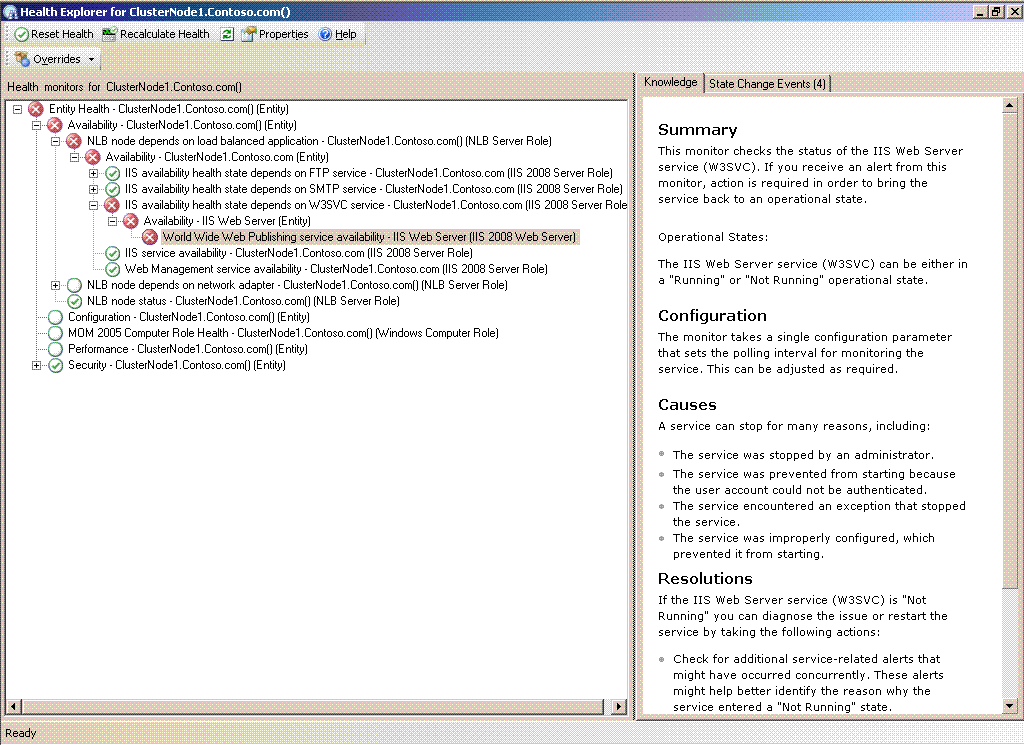Hi NLB users,
4/27/2009 - UPDATE: The System Center Operations Manager 2007 NLB Management Pack described below has been released.
I just came back from TechEd 2008 which was held at Orlando this year. It was huge for Failover Clustering! We had many events going on as mentioned in our earlier post ( http://blogs.msdn.com/clustering/archive/2008/05/31/8567150.aspx ). The turnout from the clustering fans was phenomenal, with everyone super excited about the many changes we’ve done in Failover Clustering in Windows Server 2008.
We had presence for Network Load Balancing (NLB) in the conference as well. There was a hands-on-lab for NLB. We also had great NLB coverage in the “SVR362 How to Build a High Availability Infrastructure for Web Scenarios” (presented twice). And, also talked about the new management pack (MP) for SCOM 2007 in the “MGT381 Overview of the New and Updated Management Packs in Microsoft System Center Operations Manager 2007” talk.
I’m very excited to share with you the information that was presented in the MGT381 session, as related to the upcoming NLB MP.
If you have an NLB cluster providing scale-out and high availability for your IIS workload with all your important websites, you’ve probably noticed that NLB is not aware of the health state of IIS. That is, if IIS service stops or if your web page is failing for some reason on one of your cluster nodes, the NLB network driver doesn’t know anything about that. That happens because NLB is so low on the networking stack that it isn’t aware of the health state of applications running above it. The end result is that a portion of your client traffic is going into a black hole.
With the new NLB MP, we are bringing application health awareness to NLB!
You need a SCOM 2007 monitoring server (of course) with the new NLB MP and IIS MP. Then, once you push the OM agent to the servers in your environment, the discovery logic runs and finds which machines are part of an NLB cluster, which are IIS servers, and which are both. Now, your NLB clusters are “discovered” as you see here. Notice the detailed information given on each cluster at the bottom. You’ll also see the NLB cluster nodes and details on each node in the “NLB Node State” view.

Now, with the new NLB MP and IIS MP, you get IIS health awareness in NLB. And, also diagrams that easily show the health state of your NLB cluster, nodes, and IIS roles on the nodes, as shown here with the green check marks for the 10.1.1.102 two-node NLB cluster running some IIS roles.

The health state of NLB node is reported by the NLB MP. And, that of IIS is reported by the IIS MP.

And, both MP’s work together to bring NLB application health awareness. That is, when IIS MP detects a failure in IIS on a machine, and when this failure is surfaced up the entity health tree as shown below, the NLB MP will automatically stop NLB on that node to bring that NLB node out of the rotation. And, as you see below, you get the knowledge base built into the IIS MP.

And, there is a state history displayed for each entity as you can see here.

Once the IIS problem is resolved, IIS MP reports the health back to green, and NLB MP will start NLB on that node bringing the node back to rotation.
And, with all this state change history stored in the SCOM 2007 database, we can generate reports on your NLB clusters’ availability over time.

Additionally, you can model your end-to-end solutions with the new SCOM 2007 modeling capability. This allows you to monitor your solution (which might include a web front end using IIS on NLB, and a back end SQL server made highly available via Failover Clustering) end-to-end instead of monitoring the pieces or servers separately. Just build your solution model, and drag and drop your actual servers/clusters onto the model to get an end-to-end monitor of your solution. Very simple!
Please note that this is under development, so, the screen shots above are subject to change before the MP’s are released.
Regards,
Ahmed Bisht
Program Manager
Clustering and High Availability – Microsoft
This posting is provided "AS IS" with no warranties, and confers no rights.
Use of included utilities are subject to the terms specified at
http://www.microsoft.com/info/cpyright.htm